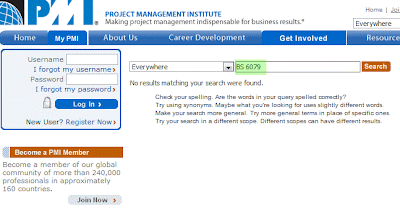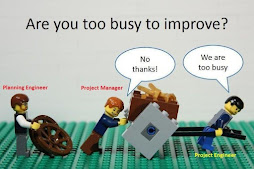Evolution of a new PM generation in India
“The team is fully geared and motivate to commission the refinery ahead of its initial schedule of December 2008. RPL is thus poised to create a new world record for project implementation in the global refining sector,” - Mukesh Ambani (RPL chairman) New Delhi, 22-July -08
Today, 25-Dec-08 , Reliance Industries Limited (RIL) of India has announced that the ‘World’s BIGGEST Refinery’ at Gujarat , India, is all set to start on 28-Dec-08 on the birth anniversary of it’s founder chairman.
A remarkable project which attracted world attention for its size, complexity, low cost and above all project management excellence is getting completed.
Combined with the existing facility, the total production capacity of RIL-Jamnagar will be 1241000 barrels per day (bpd) which is 1.32 times bigger than the one next to it, which is Paraguana Refining Complex at Venezuela.
A Project Progress Report published by the company in 15-Jan-2008 indicated 82% completion, ahead of schedule in just 2 years since kick off! The Engineering efforts (Basic & Detailed Engineering) for this project were completed in less than 2 years which has set a global record in refining sector.
Completing a sophisticated project of this size in just 3 years is just incredible! All credits go to visionary management of RIL and dedicated PM professionals and labours at the Jamnagar site!
I would recommend you to visit this page in the reliance website which talks about “Innovation @ Reliance” I think the black mark on Indian project managers caused due to severely mismanaged public sector projects, which were famous for over-runs and ‘never-ending’ behaviour, is an old story now. Cost effectiveness, speed of execution, technical expertise and quality are the trademarks of the new generation Indian PM’s.
Efficiency of Indian PM’s came to world’s attention only after the IT revolution. MNC’s employed Indian professionals at their development & research centres abroad in huge quantities. Every IT major has started facilities & operations in India, leveraging on the technical/managerial expertise and cost effectiveness. It is to be noted that much before the IT revolution, many large corporations in the US line NASA & IBM had employed Indian professionals in large numbers.
What Europe is for IT Project Managers, is Middle East for Industrial/Infrastructure Project managers from India. Millions of Indians work in various countries in infrastructure & industrial projects including thousands of Project Managers in various disciplines. The knowledge earned from international projects may help Indians to better PM practices in India.
Where Indian Project Managers are lacking?
(This section focus on Construction projects only. Project Management in service & IT sectors are much better organised in India)
From my personal experience I have found that Indian project professionals are hard working (Veterans of execution) but lack the following:
- Still many of the major projects lack proper ‘Formal’ planning
Project planning is still in its infancy in India. A preliminary schedule prepared in MS Project (or sometimes in MS Excel!) which hardly gets its update is all about the construction project management in many projects. Many senior officials in Project management sector don’t understand the formal planning concepts. S-Curve, Resource Histograms, cost baseline & EVM are just alien terms for them. There is always a hurry seen in starting execution before the formal planning is completed and performance measure & control systems are created. I heard many people saying “Erect the big structures and equipments first so that we can show some really nice early progress”. Effective sequencing of activities was often not done resulting re-work. Planners are not really respected and execution team always dominates and does not give proper inputs to Planning & Project control. Many people don’t understand the big truth that planning coordinates everyone’s efforts thus reduces duration and rework.
Shortage of ‘Trained’ professionals in Project Management are the reason for sidelining the planning function in Indian Project Management Scenario.
- Documentation is not up to international standards
One of the major characteristic of international projects is extensive and comprehensive documentation. Projects documents can generally be classified as:
- Technical / Engineering documents
- Quality documentation
- Planning & general project management documents
- Procurement & finance/Cost related documents
- Project communication
In Indian industrial projects, ‘a’ and‘d’ are found to be maintained reasonably well. How ever the remaining 3 types of documents ( ‘b’,’c’ and ‘e’) are not really maintained well!
A properly documented project ensures smooth execution and helps the project team by functioning itself as a guide for future projects
- Safety is not meeting international benchmarks
Safety is talked every where unlike olden days where execution was the only concern for construction professionals. How ever safety standards in Indian construction projects, especially civil, are far below international benchmarks. In one of the large projects which I have worked, the civil contractor ruled out usage of safety shoes for civil labour saying that ‘Rural labour force used were not comfortable in wearing heavy safety shoes and denied repeated instructions for usage of the same” They used low quality slippers and helmets made of recycled plastic ! Attempts for strict implementation of proper PPE on them drastically reduced project progress and at a critical stage, the site management team relaxed the PPE norms for the civil construction team!
Scaffolding, scissor lifts and even proper ladders are still ‘Luxury’ for Indian construction. A standard Indian supervisor will encourage the worker to perform a “Ripley's believe it or not” act if a proper safe working way is ‘too costly”. There are lots of ‘Safety Training Institutes’ mushrooming in India. How ever none of these professionals can find a job market with in India.
- No formal project closing
I was not fortunate to see a formal project closing in India which is limited maximum to a cocktail party in the nearby hotel! We don’t have to search for another reason for repeated over-runs in schedule & cost projects after projects.
I would like to quote a catching line for the Relience website "First time it is learning. Second time it is a mistake." – and it explains all !
But Why ?
The answer is money!
- Projects in India are executed in tight budget
- Salaries of PM & construction professionals are relatively low
- Lack of trained PM professionals in construction filed
The third point can be related to the second one since, many of the educated and trained professionals opt of jobs abroad which give better financial benefits. Apart form this, basic change of mindset is to be done, which focus on only 1 (Execution) and nearly ignores /dilutes rest of the 4 Project management process groups (Initiation, Planning, Monitoring & Control and Closing).
Where to look for examples?
I feel British are the people who respects planners most! I was amazed to experience this myself.
Indian PM’s can learn a lot form the commitment and importance which British PM’s give to planning, systems, quality and safety.
Americans focus greatly on cost control. NASA has set lots of standards for Project & Programme management. PMI, a US based Project Management organization is considered as the largest project management organisation in the world.
Japanese are real hard workers and focus greatly on productivity. They are not less than anyone in creativity or innovation also.
Final thoughts
Indians possess a right blend of hard work and intelligence. If the raw talent, which is abundant, subjected to formal training (by those who are experienced from international projects) can do wonders for the PM scenario in India. Recent establishment of an Indian subsidiary of PMI (the one & only wholly owned subsidiary of PMI USA) in New Delhi can be seen as the realisation of PM potential of India.
Industrial production decides the progress & wealth of the nation.
Well executed projects (schedule, cost, quality & safety) will have serious positive impact on Indian economic scenario. In the age of recession, ‘effectiveness’ and ‘efficiency’ matters lot!
Links










































